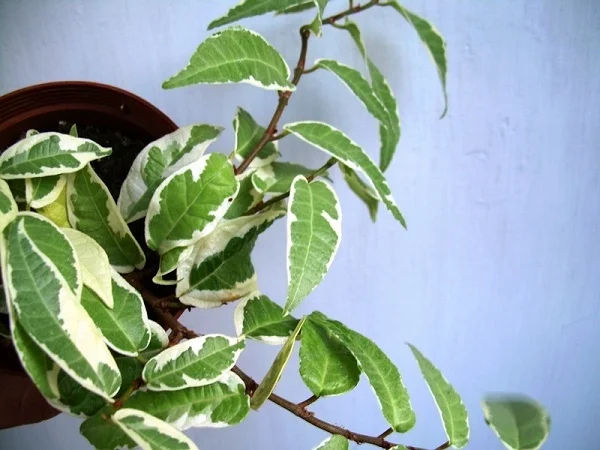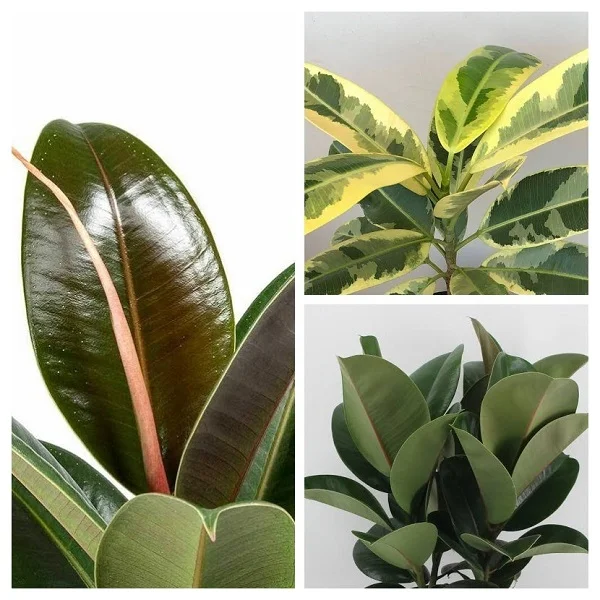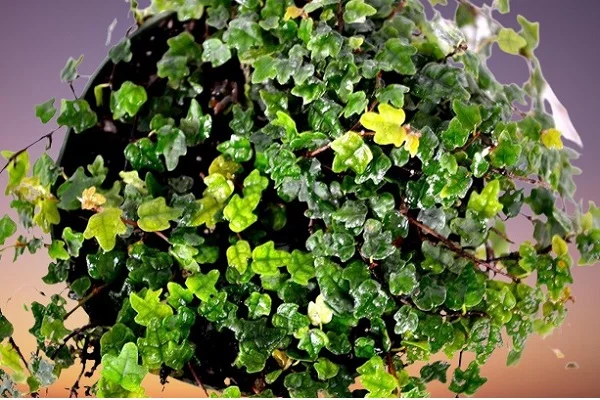Mistletoe Fig (Ficus deltoidea) Care Indoors, Propagation, Common Problems and Fixes
Some links in this post may be affiliate links
Mistletoe Fig Plant (Ficus deltoidea) grows best in bright light with some direct sunlight, warm and humid conditions and moderately moist, fertile, well-drained soil coupled with monthly feeding during the growing season.
Ficus deltoidea thrives with basic care. This guide will cover everything you need to know about growing and maintaining Mistletoe Fig indoors, from light and watering needs to soil, propagation, and common problems.
Mistletoe Fig also called Delta Fig or Fig Shrub is a slow-growing, evergreen, shrubby plant which bears glossy green leaves on top, golden yellow below with black spots and prominent veins.
The leaves in female plants are big and round while in male plants they are small, round and long. The species name, 'deltoidea', is in reference to the leaf shape which resemble the Greek letter, 'delta'.
Delta Fig bears characteristic fig berries through out the year which start off white then turn red as they mature. The berries are inedible.
Fig Shrub is considered more drought tolerant than most Ficus varieties as it can withstand short periods of dryness.

Botanical name: Ficus deltoidea
Synonmy: Ficus diversifolia
Family: Moraceae
Common names: Mistletoe Fig, Delta Fig, Fig Shrub
Origin
Ficus deltoidea is native to South East Asia. It can grow as a terrestrial, a lithophyte or as an epipyhte. The epiphytic growth gives it the common name, 'Mistletoe', as it grows like a mistletoe.
Size
Ficus Mistletoe Fig can grow to a height of 18 feet in its native habitat. Indoors, it grows to a height of about 3-5 feet and the same width. It may take 10-20 years to reach this size. It is one of the best trees for indoor growing.
Is Mistletoe Fig toxic to pets?
Like other plants in the Moraceae family, Ficus deltoidea is toxic to humans and pets as indicated by Pet Poison Helpline. Ficus plants produce a milky white latex which is an irritant to the eyes and the skin. If ingested it can cause irritation in the mouth, drooling, vomiting, diarrhea, loss of appetite and abdominal pains. Keep Mistletoe Fig away from children, cats. dogs and other pets.
Why grow Ficus deltoidea indoors?
- Attractive foliage: Glossy, rounded green leaves with a leathery texture.
- Compact growth: It stays small, making it ideal for apartments, offices, and tabletops.
- Low maintenance: Requires minimal watering and care.
- Drought-tolerant: It stores water in its thick leaves, reducing watering needs.
- Ornamental fruits: Produces tiny, inedible figs that resemble mistletoe berries.
Where to Buy
Mistletoe Fig is a beautiful plant to add to your collection, it is available online on Etsy (Link to Etsy).
Caring for Ficus deltoidea Indoors
Caring for Ficus deltoidea entails providing it with bright light with 4-6 hours of direct sunlight, average warmth of 15-260C, humidity of 60-75% and moderately moist, fertile, well-drained soil coupled with monthly feeding in the growing season.
Mistletoe Fig care requires repotting every 1-2 years when the plant is pot-bound. Regular pruning is needed to keep the plant tidy, reduce pests and diseases as well as control growth and encourage growth of a compact plant. Keep on reading for more on these growing conditions and how to achieve them.
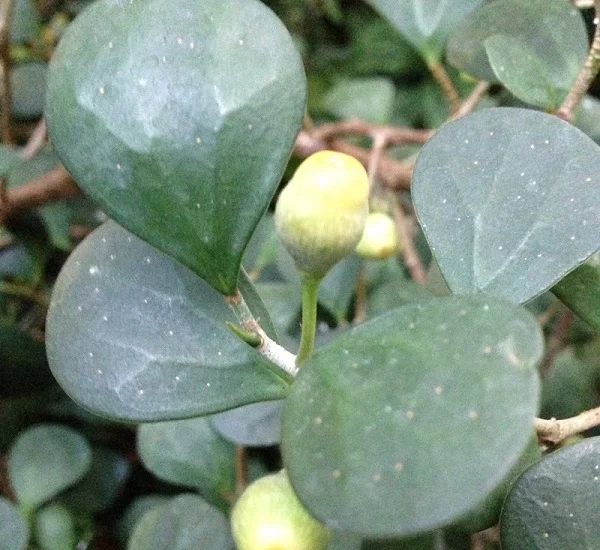
Watering
Water your Mistletoe Fig liberally during the growing season until water comes out through the drainage holes and allow the top 2-3 inches of soil to dry out between waterings. Keep the soil moderately moist and avoid overwatering.
Decrease watering in the cold season to maintain the soil barely moist as growth is reduced at this time. Use water that is at room temperature as cold water can cause reduced growth and leaf drop.
Delta Fig is sensitive to chlorine and other chemicals dissolved in water. Use only chlorine-free water to water the plant to avoid spots on the leaves. Make sure that the pot has a drainage hole to prevent the soil from getting soggy as it can lead to leaf drop and root-rot.
If the leaves start curling or turning yellow, check the soil moisture; both overwatering and underwatering can cause similar symptoms.
Light Requirements
Mistletoe Fig Plant grows best in bright light with 4-6 hours of direct morning or late afternoon sunlight. Avoid exposing it to hot middat sunshine as it can cause scorching (brown marks on the leaves) and eventual leaf drop.
Ficus deltoidea can adapt to lower light conditions but it will grow much slower. If light is too little it may result in leggy growth, yellowing and leaf drop. You may grow the plant under a grow light if natural lighting is insufficient.
Turn the pot regularly to ensure that the Delta Fig receives light on all sides for even growth and prevent lopsided growth.
Temperature and Humidity
Mistletoe Fig does well in an average warmth of 15-260C. Keep the it away from drafts to prevent sudden changes in temperature as they can cause leaf drop.
Ficus Mistletoe Fig can grow in average room humidity but to thrive, it requires above average humidity of 60-75%. To elevate humidity, set the pot on a wet pebble tray. Make sure there is good airflow to discourage fungal diseases.
Fertilizer (Feeding)
Feed your Ficus deltoidea every 3-4 weeks during the growing season with a balanced, water-soluble fertilizer for lush growth. Do not feed in the cold season as growth is minimal and feeding at this time can cause fertilizer burn.
Potting Mix
Mistletoe Fig Plant soil should be rich in organic matter and well-drained to prevent it from getting soggy while providing the required nutrients. All purpose potting mixes are great for this plant.
Repotting
Repot your Ficus Mistletoe Fig at the beginning of the growing season only when it has become root-bound. Repotting every 1-2 years is adequate for this plant. Avoid frequent repotting as it grows best when pot-bound.
Repot only when it has outgrown its current pot, that is, when the roots begin to grow through the drainage holes. Use a pot 1 size larger and one that has a drainage hole to prevent the soil from getting soggy. Never allow the roots to sit in soggy soil as it can result in leaf drop and root-rot.
For a large plant which may be difficult to handle, replenish the top 2-4 inches of soil with fresh soil annually while taking care not to injure the roots. Check out these ceramic pots on Amazon.
Pruning & Grooming
Pruning Mistletoe Fig Plant is easy. Remove dead and yellow leaves to maintain the plant neat and tidy as well as reduce pests and diseases infestation.
When the plant has reached maximum height or it has become leggy, cutback the branches with a sharp, clean pair of pruning scissors to rejuvenate growth and also encourage a bushy, compact growth. You may use the foliage emanating from the pruning to propagate new plants.
Regularly clean the leaves by damp-wiping with a soft cloth to get rid of dust and also discourage pest and disease infestations.
Propagation
Ficus deltoidea propagation can be done during the growing season by air layering or by stem and stem-tip cuttings.
Ficus deltoidea propagation by Air Layering
- Air layering involves notching the stem of a healthy Mistletoe Fig and coating the notch with a rooting hormone for faster establishment.
- Surround the notched area with damp moss and cover the notch with a polythene film or clear plastic wrap.
- Once the roots have formed, sever the stem just below the covered part. Remove the polythene or plastic wrap and carefully pot the rooted cutting in moist well-drained soil.
- Ascertain that the pot has a drainage hole to prevent the soil from getting soggy as it can lead to rotting.
- New shoots will sprout from the shortened stem of the old plant into a beautiful bushy plant.
- Position the new Delta Fig in a warm, brightly-lit spot and maintain the soil moist until the plant is well established after which you can begin routine care.
Ficus deltoidea propagation from stem cuttings
- Take non-woody stem or stem-tip cuttings about 6 inches long from a healthy Mistletoe Fig. Strip off the lower leaves from the cutting and retain 2-3 leaves on top.
- Allow the sap to dry and then dip the lower cut end cutting in a rooting hormone to hasten rooting.
- Insert the cutting in moist rooting soil. Ensure that the rooting container has adequate drainage to prevent the soil from getting soggy to avoid rotting of the cuttings.
- To enhance rooting of the cutting, create a mini-greenhouse by covering the set up with a clear polythene bag or sheet.
- Ensure the leaves do not touch the bag or the sheet too much by propping it up with sticks.
- Place the set up in warm, brightly-lit spot and maintain the soil moist through out until new growth emerges.
- New growth indicates that the cutting has rooted. In about 3-4 weeks, rooting will have taken place.
- Gradually over a period of two weeks, remove the plastic cover to acclimatize the new plant.
- In 4-6 months, there will be adequate root development and you can transplant the new plants into individual pots after which you can begin Delta Fig routine care.
Related: How to propagate Rubber Plant (Ficus elastica Propagation).
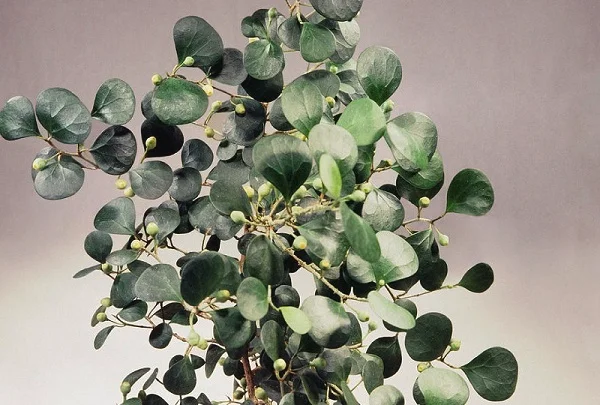
Mistletoe Fig Problems
Ficus deltoidea problems include yellow leaves, leaf drop, drooping leaves, diseases and pests among others. Keep reading for more details on these problems and how to fix them.
Yellow leaves
Some of the causes of yellow leaves on Mistletoe Fig are improper watering, soggy soil and too little light.
How to fix it
Incorrect watering: Water the plant when the top 2-3 inches of soil dry out. Cut down on watering in the cold season but do not allow the soil to dry out completely.
Soggy soil: Confirm that the pot has a drainage hole and that the soil is well-drained to prevent it from getting soggy.
Too little light: Make sure that the plant receives bright light with 4-6 hours of morning or late afernoon sunshine. You may also instal a grow light if the natural lighting is not adequate.
Leaf drop
Leaf drop in Mistletoe Fig is due to sudden changes in the growing conditions, extreme temperatures, and too little light.
How to fix it
Sudden change in the growing conditions Always acclimate the plant gradually to new growing conditions. For instance, if you want to take it outside, move it to a shaded place first before you can expose it to bright light.
Extreme temperatures: Keep the plant away from drafts to maintain average temperatures of 15-260C.
Too little light: Move the plant to a brighter spot where it will receive bright light with 4-6 hours of direct sunshine.
Drooping leaves
Drooping leaves on Mistletoe Fig Plant is due to inconsistent watering, hot direct sunlight, and temperature stress.
How to fix it
Inconsistent watering: Water the plant when the top 2-3 inches of soil dry. Decrease watering in the cold season but do not allow the soil to dry out completely.
Hot direct sunlight: Keep the plant away from hot midday sunshine.
Temperature stress: Protect or keep the plant away from drafts emanating from hot air vents, AC units, windy doors, drafty windows among others.
Brown leaf tips and edges
Brown leaf tips and edges on Mistletoe Fig is caused by too low humidity. Set the pot on a wet pebble tray or use a cool mist humidifier to increase humidity. You may also grow the plant in the moist areas in the home.
Pests
Common pests in Mistletoe Fig are aphids, mealybugs, scale insects and spider mites. Isolate the affected plant to prevent spread to other plants and treat with neem oil as directed by the manufacturer. Keep the plant properly pruned at all times to reduce the hiding places for these pests.
Diseases
Mistletoe Fig Plant is prone to root-rot disease which is enhanced by soggy soil. Ensure there is free drainage of both the soil and the pot and also reduce watering during the cold season.
Conclusion
Mistletoe Fig (Ficus deltoidea) is a low-maintenance, compact, and visually appealing houseplant. Whether displayed as a bonsai, tabletop plant, or hanging pot, it thrives with minimal care. By following proper lighting, watering, and propagation techniques, you can enjoy a healthy and thriving Ficus deltoidea for years.
Frequently Asked Questions
1. How much sunlight does Mistletoe Fig need?
Mistletoe Fig thrives in bright, indirect light but can tolerate some shade.
2. How often should I water Ficus deltoidea?
Water Ficus deltoidea when the top 1–2 inches of soil are dry. Avoid overwatering.
3. Can Mistletoe Fig grow in low light?
Mistletoe Fig can survive in moderate light, but too little light may cause leggy growth and leaf drop.
4. Why are my Mistletoe Fig’s leaves turning yellow?
Yellowing is often due to overwatering or poor drainage. Ensure the soil dries slightly between waterings.
5. Is Mistletoe Fig toxic to pets?
Yes, Mistletoe Fig is mildly toxic to pets if ingested. Keep it out of reach of cats and dogs.
6. How fast does Mistletoe Fig grow?
Mistletoe Fig has a slow to moderate growth rate, making it easy to maintain indoors.
You liked it? Share on social media.
Related Content
Amazon Associates Disclosure
Homeplantsguide.com is a participant in the Amazon Services LLC Associates Program, an affiliate advertising program designed to provide a means for sites to earn advertising fees by advertising and linking to amazon.com.



